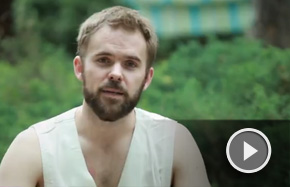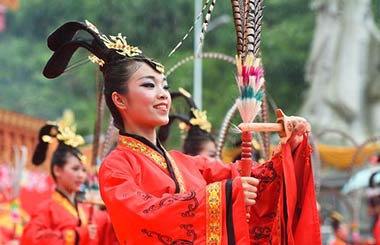Dancer took an unlikely path to international success
By Chen Jie ( China Daily ) Updated: 2012-11-16 09:10:41Central China's Hunan province has a rich base of folk music and local operas, which has nurtured at least three contemporary artistes who are famed for mixing East and West.
Related: Making the case
Composer Tan Dun drew inspiration from the rural ritual music; theater director Chen Shizheng learned Huagu Opera; while his classmate at the Hunan Arts School, Shen Wei, learned another local opera, Xiangju.
But now al ,l three are active artists abroad.
Shen is the second of three boys in the family. His father, a playwright and director of a local Xiangju Opera troupe, forced all three of them to study traditional Chinese painting, calligraphy and classical literature.
In 1978, Hunan Arts School recruited children to learn folk opera. Shen was one of two students from his county to be admitted.

"I was a quiet boy, enjoyed painting with traditional brush pen and never thought of becoming an actor on stage," he recalls. "But my parents were happy. It was expensive to feed three boys at that time, and the Hunan Arts School is government-funded and covered everything. I would get a secure job after graduation."
After six years' intense training, he was assigned to perform with Hunan Xiangju Opera House in 1984. But Shen, who loved painting, started to learn Western oil painting.
"I was fascinated by Michelangelo, Da Vinci, Rembrandt and many others. The techniques are so different from the traditional Chinese painting - like fresh air for me."
He was so entranced that he quit his theater job, rode a bicycle and carried a canvas to paint everywhere, all the while studying Western art history. He even applied for the Central Academy of Fine Arts in 1987 and 1988, scoring second and fifth among applicants respectively in painting but failing other exams, such as English.
He lost his job and did not know how to move on. His fretting mother spotted a notice of a dance competition in Hunan.
"She asked me to have a try because she thought I had perfect dance and theater training," he says.
"I actually did not receive any professional training in ballet, Chinese dance or whatever. I had to dance my own way. I chose Beethoven's Fifth Symphony (Fate)."
To his own surprise, he won.
"Maybe because the jury was fed up with those classical dances or maybe the Fate symphony woke them up," he says.
One judge urged him to join Guangzhou Soldiers Song and Dance Ensemble, and he returned to a government-funded troupe. His body did all the classical movements and gestures but his creative mind wanted more.
Guangzhou was the frontier city of China's reform and opening-up policy, giving Shen a chance to learn from many contemporary choreographers and dancers from the United States and Europe.
In 1991, he became a founding member of China's first modern dance company, the Guangdong Modern Dance Company.
He admired the work of American choreographers Alwin Nikolais and Murray Louis, and he sent a video of his dance to their studio.
Soon he got a three-month scholarship from the Nikolais/Louis Dance Lab. He moved to New York City in January 1995 and thrived as a "poor" but "happy" artiste at SoHo. But fame finally found him.
In 2000, the Guangdong Modern Dance Company commissioned him to choreograph a piece for its Europe tour. Folding became an instant success in Europe. The same year, American Dance Festival commissioned him to create Near the Terrace, which made him a celebrity in the country.
But he's not so famous in China.
"It is said the fastest way to be well-known overnight by all Chinese is to perform at CCTV's Spring Festival Gala. Thank God, the producer has yet to approach me," he jokes.
chenjie@chinadaily.com.cn
|
|
|
|
|
|
|
|
























 Raymond Zhou:
Raymond Zhou: Pauline D Loh:
Pauline D Loh: Hot Pot
Hot Pot Eco China
Eco China China Dream
China Dream China Face
China Face





